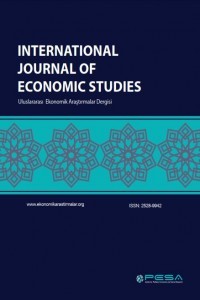Türkiye'de Enerji Yoğun Sektörler Üzerine Uygulanan Karbon Vergilerinin Refah Üzerindeki Etkileri: Genel Denge Analizi
Çalışmada, Kyoto sonrası dönemde olası emisyon yükümlülüğü durumunda Türkiye’nin uygulayacağı karbon vergilerinin etkisi Genel Denge Analizi ile incelenmiştir. Analiz TUİK tarafından yayınlanan en son 2002 yılı Girdi-Çıktı tablosu baz alınarak enerji yoğun olan ve enerji yoğun olmayan sektörlerin toplulaştırılarak yapılmıştır. Analiz sonucunda karbon vergilerinin GSYİH üzerinde negatif etkisinin olduğu görülmüştür.
Anahtar Kelimeler:
Enerji Sektörü, Karbon Vergisi, Genel Denge Analizi, Türkiye, GAMS
The Wealth Effect Of Carbon Taxes On Energy Intense Sectors In Turkey: General Equilibrium Analysis
In this study, the effect of post-Kyoto carbon tax in the case of emissions liabilities of Turkey examined with General Equilibrium Analysis. Analysis carried out with the input-output table latest published by TUIK (2002) based on the in energy-intensive and non-energy intensive sectors are aggregated. As a result of the analysis it was found that carbon taxes was negative impact on GDP
Keywords:
Energy Sector, Carbon Tax, General Equilibrium Analsis, Turkey, GAMS,
___
- Arrow, K. J. (1974), “General Economic Equilibrium: Purpose, Analytic Techniques, Collective Choice,” The American Economic Review, June 1974, 253-272.
- Arrow, K. J, G. Debreu (1954), “Existence of An Equilibrium for A Competitive Economy,” Econometrica 22, 265-290.
- Aydın, L. (2007), “Enerji Politikalarının Türkiye Ekonomisi Üzerine Etkileri: Türkiye İçin Genel Denge Analizi”, Ankara Üniversitesi Sosyal Bil. Ens. Yayımlanmamış Doktora Tezi, Ankara, 8-13.
- Böhringer, C. (1998), “The Synthesis of Bottom-up and Top-down in Energy Policy Modeling”, Energy Economics, 20(3), 233-248.
- Bulutay, T. (1979), Genel Denge Kuramı, Ankara: Ankara Üniversitesi Siyasal Bilgiler Fakültesi Yayınları No:434.
- Derviş, K., J. De Melo ve S. Robinson (1982), General Equilibrium Models for Development Policy, Cambridge University Press, Cambridge.
- Gale, D. (1955) “The Law of Supply And Demand,” Mathematica Scandivica, Vol: 3, ss: 155-169.
- Jorgenson, D. and P. Wilcoxen (1990), “Environmental Regulation and Us Economic Growth”, The Rand Journal of Economics, 21(2), 314-340.
- Koutsoyiannis, A. (1997), Modern Mikro İktisat, Gazi Kitabevi, Çev: Muzaffer Sarımeşeli, Ankara.
- Köse, A. H. ve E. Yeldan (1996), “Çok Sektörlü Hesaplanabilir Genel Denge Modellerinin Veri Tabanı Üzerine Notlar: Türkiye 1990 Sosyal Hesaplamalar Matrisi”, ODTÜ Gelişme Dergisi, 23(1), 59-60.
- Mas-Colell, A., M. Whinston, and J. Green (1995), Microeconomic Theory, Oxford Univer-Sity Press New York.
- McKenzie, L. (1954) “On Equilibrium in Graham’s Model of World Trade And Other Competitive Systems,” Econometrica, 22, 147-161.
- McKitrick, R. (1998), “The Econometric Critique of Computable General Equilibrium Mod-Eling: The Role of Functional Forms”, Economic Modelling, 15(4), 543-573.
- Neumann, J. V. (1946) “A Model of General Economic Equilibrium,” Review of Economic Studies, Vol: 13, ss: 1-9.
- Norton, B., R. Costanza, and R. Bishop (1998), “The Evolution of Preferences:: Why Sovereign' preferences May Not Lead to Sustainable Policies and What to Do About It”, Ecological Economics, 24(2-3), 193-211.
- Panagariya, A. and R. Duttagupta R (2001) “The Gains From Preferential Trade Liberalization In The CGE Models”, Regionalism and Globalization: Theory Andpractice, 39.
- Rivers, N. (2011), “Modelling Climate Change Policy: Adderssing the Challanges of Policy Effectiveness and Political Acceptability”, Simon Fraser University, Ph. D. Thesis, 29 March 2011, 20-42.
- Rutherford, T. (1995), “Extension of Gams for Complementarity Problems Arising in Applied Economic Analysis”, Journal of Economic Dynamics and Control, 19(8), 1299-1324.
- Sayan, S. (1994), “An Analysis of the Effect of Changes in Saving Rates Using Neoclasical CGE Models:Lessons From Analytical Solutions To Simple Two-Sector Models with Endogenous Interset Rates”, Bilkent University Discussion Paper, No:94-11, 1-16.
- Scarf, H. (1990), “Mathematical Programming and Economic Theory,” Cowles Foundation Paper, 763, 377-385.
- Sue-Wing, I. (2004), “Computable General Equilibrium Models And Their Use İn Economy-Wide Policy Analysis”, Technical Report 6, MIT Joint Program on Science and Policy of Global Change.
- Ünlükaplan, İ. (2006), “Kamu Borçlanması ve Nesiller Arası Yük Sorunu”, Çukurova Üniversitesi Sosyal Bil. Ens. Yayımlanmamış Doktora Tezi, Adana, 37-69.
- Wald, A. (1951) “On Some Systems of Equations of Mathematical Economics,” Econometrica, Volume: 19(4), ss.368-403.
- http://www.tuik.gov.tr/AltKategori.do?ust_id=16, (Erişim: 03.010.2012).
- ISSN: 2528-9942
- Başlangıç: 2015
- Yayıncı: Politik Ekonomik ve Sosyal Araştırmalar Merkezi
Sayıdaki Diğer Makaleler
Okun Yasası: Türkiye Üzerine Bir Uygulama
Linkages Between Market Capitalization and Economic Growth: The Case of Emerging Markets
Gökhan DÖKMEN, Ahmet AYSU, Mehmet Fatih BAYRAMOĞLU
Maliye Alanında e-Teknolojiler ve Etkinliği
Şirketlerin Vergi Borcunu Ödemesinde Perde Arkasındaki Temsilcilerin Sorumluluğu
